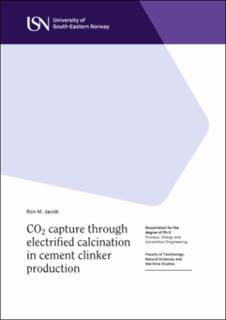| dc.contributor.author | Jacob, Ron M. | |
| dc.date.accessioned | 2023-08-16T07:47:46Z | |
| dc.date.available | 2023-08-16T07:47:46Z | |
| dc.date.issued | 2023-08-31 | |
| dc.identifier.isbn | 978-82-7206-789-1 | |
| dc.identifier.issn | 2535-5252 | |
| dc.identifier.uri | https://hdl.handle.net/11250/3084303 | |
| dc.description.abstract | The cement industry has the second highest share of industrial CO2 emissions, and two-thirds of these emissions come from decomposing its key ingredient by the calcination reaction (CaCO3 → CaO + CO2). This thesis studied the electrification of the calcination process. Electrified calcination will produce a relatively pure CO2 stream, which can be sent for direct utilization/storage, thereby avoiding a separate CO2 capture plant.
The main aim of the work is to recommend a suitable design for an electrified calciner heated by resistance heating technology. The main aim is achieved by answering four key questions related to 1) impacts on the mass and energy balance, 2) technical feasibility, 3) heat transfer efficiency, and 4) design recommendations. The key questions are answered by performing a mass and energy balance using Aspen Plus, experimental studies of different calciner designs, 1-D and transient modelling of different calciner designs, and computational particle fluid dynamics (CPFD) simulations of a fluidized bed calciner design.
The mass and energy balance results show that the CO2 emissions can be reduced up to 78% by using an electrified calciner instead of a coal-fired calciner. Moreover, a hybrid system integrating an electrified calciner with an amine-based CO2 capture unit using only internal heat integration can completely decarbonize the cement industry (i.e., close to 100% reduction). Different calciner concepts require different levels of CO2 recycling in the calciner. Increased gas recycling increases the calciner energy demand as the recycling gas must be heated. The energy demand can be reduced with heat recovery from the recycling gas. Such heat recovery is especially relevant for high and extremely high gas recycling cases. Moreover, CO2 capture from an electrified calciner is better than from a pure amine-based capture system as it requires lower input of extra energy.
The entrained flow calciner requires more than 2000 heating rods working under high gas velocities, so this design is unlikely to be technically feasible. The rotary calciner designs are technically feasible but have scale-up problems.
The fluidized bed calciner operating with a binary particle mixture is in interesting concept. Fine raw meal particles are difficult to fluidize, but cold-flow experiments have demonstrated that a mixture of raw meal and coarse inert particles can be fluidized, and subsequently segregated. A design of such a calciner also seems promising at hot flow conditions, based on results from CPFD simulations. However, the fluidized bed design should be experimentally validated also at hot flow conditions.
The fluidized bed calciner has the highest heat transfer efficiency and the lowest surface heat loss as it has a high heat transfer coefficient and high heat transfer area per internal surface area of the calciner geometry.
To conclude, the fluidized bed calciner is recommended as it has the highest heat transfer efficiency, and the concept seems promising both from cold flow tests and from CPFD simulations. An electrified fluidized bed calciner design is proposed, and this can be experimentally tested in future work. | en_US |
| dc.language.iso | eng | en_US |
| dc.publisher | University of South-Eastern Norway | en_US |
| dc.relation.ispartofseries | Doctoral dissertations at the University of South-Eastern Norway;170 | |
| dc.relation.haspart | Article 1: Jacob R.M. & Tokheim L.-A.: Electrified calciner concept for CO2 capture in pyro-processing of a dry process cement plant. Energy, 268, (2023), 126673. https://doi.org/10.1016/j.energy.2023 | en_US |
| dc.relation.haspart | Article 2: Jacob R.M. & Tokheim L.-A.: Electrification of an entrainment calciner in a cement kiln system – heat transfer modelling and simulations. Proceedings of the 62nd International Conference of Scandinavian Simulation Society, SIMS 2021, p. 67-75. https://doi.org/10.3384/ecp2118567 | en_US |
| dc.relation.haspart | Article 3: Jacob R.M., Pinheiro, J.P. & Tokheim L.-A.: Electrified externally heated rotary calciner for calcination of cement raw meal. Manuscript under review in Applications in Engineering Science. Available as an SSRN pre-print: http://dx.doi.org/10.2139/ssrn.4405001 | en_US |
| dc.relation.haspart | Article 4: Jacob R.M. & Tokheim L.-A.: Novel design of a rotary calciner internally heated with electrical axial heaters: Experiments and modelling. Results in Engineering (17), (2023), 100992. https://doi.org/10.1016/j.rineng.2023.100992 | en_US |
| dc.relation.haspart | Article 5: Jacob R.M., Moldestad, B.M.E. & Tokheim L.-A.: Electrified calciner concept for CO2 capture in pyro-processing of a dry process cement plant. Proceedings of the 62nd International Conference of Scandinavian Simulation Society, SIMS 2021, p. 333-340. https://doi.org/10.3384/ecp21185333 | en_US |
| dc.relation.haspart | Article 6: Jacob R.M. & Tokheim L.-A.: CPFD simulation of electrically heated fluidized bed calciner with binary particles. Manuscript submitted to Energy | en_US |
| dc.rights.uri | http://creativecommons.org/licenses/by-nc-sa/4.0/deed.en | |
| dc.subject | CO2 capture | en_US |
| dc.subject | electrified calcination | en_US |
| dc.subject | electrified calcination resistance heating | en_US |
| dc.subject | rotary calciner | en_US |
| dc.subject | internal heating | en_US |
| dc.subject | external heating | en_US |
| dc.subject | fluidized bed calciner | en_US |
| dc.subject | CPFD simulations | en_US |
| dc.subject | calciner design | en_US |
| dc.title | CO2 capture through electrified calcination in cement clinker production | en_US |
| dc.type | Doctoral thesis | en_US |
| dc.description.version | publishedVersion | en_US |
| dc.rights.holder | © The Author, except otherwise stated | en_US |
| dc.subject.nsi | VDP::Technology: 500::Chemical engineering: 560::Chemical process engineering: 562 | en_US |

